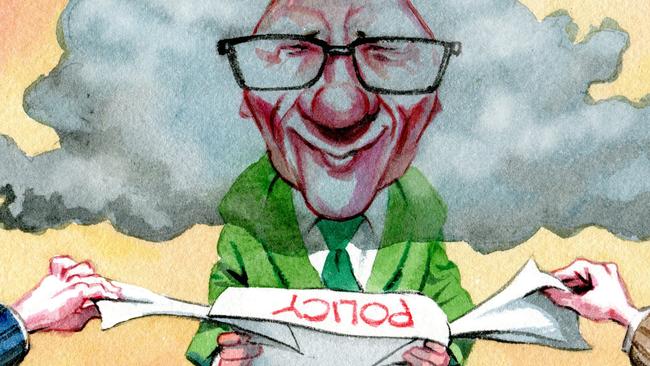
The Australian Greens were formed 25 years ago on an autumn day at Lavender Bay in North Sydney. The announcement was made by Bob Brown, then a Tasmanian Greens MP, that several state-based parties would form a national party organisation to challenge the political establishment. Hardly any media attended and the news passed mostly unnoticed.
The Greens have become one of Australia’s most successful political parties. After Labor, the Liberals and Nationals, no other party has had such success in local, state or federal politics. Whatever your view might be of the radicalism of their policies, parties usually don’t last this long.
But the Greens are now at a crossroads. The perennial question remains: are they a party of protest or power? The Greens are now engaged in a bout of soul-searching, a strategic rethink, and they are beset by factional infighting in NSW. Can the party that many deride as loopy not only survive but become the political force it hoped to be 25 years ago?
Richard Di Natale, 47, is the third leader of the Greens after Brown (2005-12) and Christine Milne (2012-15). Di Natale, a former GP from a working-class immigrant family, is more mild-mannered than his predecessors. For a start, he has never been arrested. He has been pragmatic in parliament. But, for many, the Greens’ high-taxing, high-spending, high-debt policies are too dangerous to take seriously.
The party was formed on August 30, 1992. Last week, on the 25th anniversary, I asked the unfailingly polite Di Natale how he differs from Brown and Milne. “I am my own person,” he said. “I have my own background, my own journey into politics, my own style, and that is one thing that all leaders bring to the job.”
But is Di Natale the leader the Greens need now? Myriad minor parties are vying for their own piece of real estate on the political spectrum. There are concerns within the Greens that young voters are drifting to Labor. There are worries that Di Natale is not dynamic enough to maintain and attract voter support. The Greens vote has flatlined at 9 to 10 per cent nationally and rarely exceeds the 10.2 per cent achieved at the last election. They lost a Senate seat in 2016. (Two senators have since fallen on their swords over citizenship, but will be replaced.)
They have just one House of Representatives member, Adam Bandt, and failed to snatch a further seat in Sydney or Brisbane, or another in Melbourne. Still, the Greens remain the biggest minor party in the federal parliament.
Di Natale says the environment, specifically climate change, remains the “driving motivation” of the Greens. He names the party’s pro-asylum-seeker stance as one he is “incredibly proud of”. The Greens champion peace and non-violence, and want the US alliance to be “reconsidered”. Di Natale backs democratic improvements such as a corruption watchdog and donations reform.
But Labor’s lurch to the left has hurt the Greens. As Di Natale points out, the Greens have been talking Labor policy before Labor: raising taxes on high-income earners, curbing superannuation tax breaks, reforming negative gearing to boost housing affordability, calling for a banking royal commission and legislating same-sex marriage. Labor has stolen the Greens’ mantra on inequality.
Di Natale is alive to the changing political dynamic. Even the Coalition has gone Labor-lite, according to its internal critics. “We’ve got a platform that does appeal to a significant group in the community and it’s bigger than the number of people that vote for us,” Di Natale says. “The challenge for us is to try and reach those people.” He sees Labor and Coalition voters who can be won over to the Greens.
Another challenge comes from within and concerns strategy and ideology. Senator Lee Rhiannon, an old-school Trotskyist, is a critic of Di Natale’s leadership. The NSW Greens are known as watermelons — green on the outside and red on the inside. Brown recently said Rhiannon should quit and the NSW Greens need a “clean out”. Di Natale won’t be drawn. “We have got to build a healthy culture” that gives members an “active voice”.
The Greens could be a party of protest and power, Di Natale says. He points to legislative victories on Landcare, medical cannabis and an inquiry into banking. His aim is to consolidate the Greens’ as a “balance of power” party in the Senate. He rejects the notion that he has moved the party to the centre, as evidenced by the deal almost reached with the government on Gonski 2.0.
But the bigger question remains: what is the ultimate purpose of the Greens? Is it, as Brown said, to replace Labor as the major party on the centre-left? Or is it to broker its way into power by supporting minority governments? Di Natale answers yes, it remains a goal to replace Labor, but his “primary goal” is to get Green policies implemented. Frankly, it could be clearer.
Brown wrote in his memoir Optimism (2015) that the Greens were not “pro-Labor or anti-Liberal” and he considered supporting Tony Abbott to form a government in 2010.
Di Natale says he could not envisage supporting a minority Coalition government but he would be open to a similar agreement with Labor as the one that helped prop up the Gillard government.
“Supporting the Labor Party in government with a clear agreement is something that I am certainly open to,” Di Natale says.
The remarkable thing about this is that although the Greens despise Labor and often compete for the same constituency in the city and on the coast, they would happily unite to secure power.
This is not what Bob Brown envisaged 25 years ago in Lavender Bay.



To join the conversation, please log in. Don't have an account? Register
Join the conversation, you are commenting as Logout